Stories from the City
Whenever a new set comes out, I like to take one or more columns to dive in and talk design on a card-by-card level. That means it's time for me to talk about cards from Guilds of Ravnica.
Affectionate Indrik
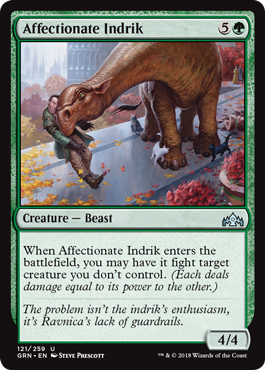
As someone who cares a great deal about the color pie (and helps oversee the current Council of Colors), I spend a lot of time in rooms arguing about whether a certain color is or isn't supposed to be able to do something. A good example of this is green's ability to deal with other creatures. For many years, green's only answer to other creatures was bigger creatures at a cheaper cost that would on occasion force (or sometimes just heavily encourage) the defending player to block it.
This just wasn't a good enough answer as creatures are such a huge percentage of the threats in an average game (especially in Limited), so we came up with the fight mechanic. This let green deal with other creatures but by using its own creatures, which felt thematic and didn't seem to be undercutting green's weakness of an overreliance on its creatures.
Green still needed a little more, so we started letting green do a "one-sided fight" where it dealt damage to another creature but that creature didn't get to fight back. The ability had originally been just in red, but we realized that green needed it more than red, so we made it primary in green and secondary in red.
It still wasn't quite enough, so next we talked about creatures that "enter the battlefield" (ETB) and fight. One of the guidelines I'd often used is that green shouldn't be able to have cards that deal with creatures if they were playing a creatureless deck. The ETB fighting creatures didn't technically break that rule as they're themselves creatures, but it was starting to get into a grayer area. For example, if we made a 1/1 creature with deathtouch and ETB fight, we were essentially making Murder, and we knew that was wrong.
We've slowly been dipping our toe into this space over the last bunch of years. Fate Reforged had an enchantment that granted the ability to fliers. Dragons of Tarkir had a seven-drop 4/5 Dragon. Eldritch Moon had a 4/3 Elk. Ixalan had a 1/4 Human Archer. Rivals of Ixalan had a creature that granted it to another creature. I think we've finally gotten to a point where we've decided it's just something green can do.
Arclight Phoenix
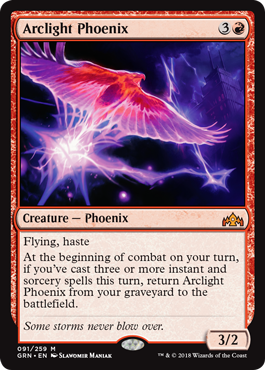
One of the challenges of making the same game for so long is that a lot of simple space has already been mined. For example, Izzet has an "instant and sorcery matters" theme. Both previous incarnations of Izzet had it as well. The theme, however, goes well beyond Izzet. It's shown up in blue and/or red in many expansions. What this means is we've designed a lot of red "instant and sorcery matters" cards. When designing new ones, we have to try finding space we haven't hit before.
The trick to doing this is being very thorough in examining effects that we do in that color. I'll use red as an example. We start with the simple "whenever an instant or sorcery gets played do a red effect." You then make a list of every red effect you can think of and see if you can find something we haven't connected to the "instant or sorcery" theme. If you dig enough, you'll usually find something new, but that search gets harder and harder each time you return to the theme. And yes, one of the answers to this is reprinting successful cards from the past that accomplish what you want to do.
Arclight Phoenix's design is a good example where the designer was trying to carve new space. Phoenixes are red. Have we ever combined a Phoenix with an "instant or sorcery matters" type of effect? You look it up and discover—yes, we have. In Magic 2012, we made Chandra's Phoenix. If you dealt damage with a red instant or sorcery (or planeswalker), you got Chandra's Phoenix back to your hand.
This means that you want to try and make your new Phoenix different in some way. Phoenixes flying and returning from the grave is their defining mechanical identity, so you have to do something in that space. Chandra's Phoenix returns the card to your hand where you have to cast it again. What if the new card just put it directly onto the battlefield? Next, you examine the triggering condition. Chandra's Phoenix cared about instants and sorceries dealing damage. You need to stay clear of that space. What if you just cared about instants or sorceries being cast?
Returning back to the battlefield after one instant or sorcery being cast was too easy. Because of jump-start—the Izzet guild mechanic—two also proved to be too easy, so it was decided to make three the requirement. Finally, to make it a bit different, it was made a 3/2 for 3R rather than a 2/2 for 1RR.
Aurelia, Exemplar of Justice
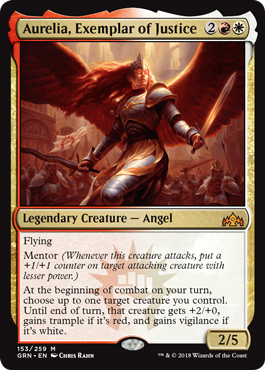
Aurelia is back, and we wanted to give Boros's battle-angel leader a cool new card. She's an Angel, so obviously she needed to fly. As a leader, we liked the idea of her having mentor as obviously, in the Boros guild, one would expect the leader to mentor others. Flying and mentor are already synergistic, but for a mythic rare (and a popular legendary character), it needed a bit more. The question was, could we come up with a mechanical way to further reinforce how she helps her people while also playing well with the rest of the card?
What if she could boost a creature of her choice? It should be at the beginning of combat as she's Boros, and they're all about combat. A power boost seemed the most useful. She was then given two more abilities each granting a keyword but only to creatures of a certain color—one for each of the Boros colors. At first blush, this might seem anti-synergistic because to use mentor, you need to have a larger power, which means boosting another creature would prevent Aurelia from mentoring them, but remember, she can use the ability on herself to allow her to mentor more creatures. Also, as she's red and white, she gets both the trample and the vigilance.
Beacon Bolt
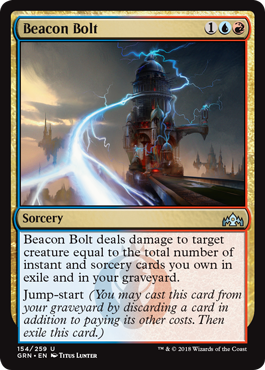
In design, it's usually the big splashy effects that get the attention, but a big part of design is sweating all the smaller details. Beacon Bolt is a good example of this. Basically, the card wants to deal damage equal to the number of instants and sorceries you've cast this game. The way you normally count that is by looking in your graveyard because that's where you put your spells after you've cast them. The problem is that the Izzet mechanic is jump-start, which only goes on instants and sorceries, exiles cards after being cast out of the graveyard. If we used the normal template, it would discourage the use of jump-start cards (or at least discourage using the jump-start ability). To offset this, we added a simple extension to the effect. Instead of just counting the number of instants and sorceries in your graveyard, it also looks at ones you own in exile. This way, your jump-start cards will still count even if you've used them out of the graveyard. The one other card in the set that checks the graveyard for instants and sorceries (Crackling Drake) also makes use of this technology.
Bounty of Might
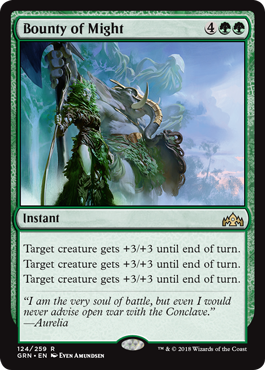
In Ravnica, we made a card called Seeds of Strength.
This card made use of a templating technology we hadn't used before: it wrote the same ability multiple times. This came about because the functionality we wanted (you could distribute the +1/+1 effect to any number of creatures including multiple times on the same one) was tricky to write out in a way that was clear to the audience without being extra wordy. This template was a novel approach to solve the problem. The template proved popular, and we've used it a bunch of times since then.
Bounty of Might is a cute nod to Seeds of Strength. You might ask why it isn't green-white if it's a nod to a green-white card. The answer is that it's not in color pie in green-white. To help separate green from white (the two colors that have the most mechanical overlap) we've chosen to give white boosts of +2/+2 and less and green +2/+2 and greater. This means +3/+3 is a green effect and thus three +3/+3s is green.
Chamber Sentry
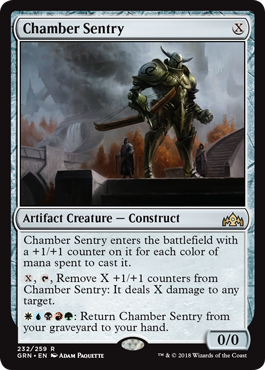
One of the things we like to do in design is create cards that encourage you to do something that the rest of the set isn't encouraging you to do quite as much. These cards can create fun drafting moments where you first-pick the card and start down the path of making it work. It also allows you to build fun casual Constructed decks on a different theme. Chamber Sentry is a good example of this type of card.
For the most part, Guilds of Ravnica encourages you to draft or build two- and three-color decks. Chamber Sentry strongly urges you to consider playing all five colors. One of the subtler ways it does this is by allowing you to play the card no matter how many colors you have access to but then letting you use the last ability once you have all five. You then get to replay the card at its maximum size. I also enjoy how the second ability gets the card into the graveyard, allowing you to continually use the third ability.
Chance for Glory
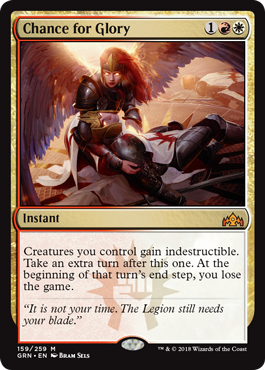
At first blush, you might not think we'd ever put the words "You lose the game" on a card. After all, why would anyone cast a card that says, "You lose the game"? The answer is you have to make it worth the player's while.
The very first "you lose the game" card was printed in Limited Edition (Alpha). Lich was a "deal with the devil, downside lose the game" card. The game loss was more of a threat than a promise. You got great power, but it came with the ultimate risk—it could cost you your life (aka the game).
The second "you lose the game" card was Amulet of Quoz in Ice Age. It flipped a coin, and the loser of the coin flip lost the game. The opponent could ante an additional card to prevent the coin flip from happening. The reason ante was involved was because the designers didn't want players using the card moments before they were about to die when they had nothing to lose.
A year later, Mirage introduced two new cards that both came with the risk of losing the game.
Forbidden Crypt was another "deal with the devil" black card. Final Fortune was something a little different though. All of the previous cards made game loss a possibility. Final Fortune made it a certainty. If you cast it, you needed to win before it made you lose. Final Fortune would be the first high-profile game-loss card. (Final Fortune would be redone in Portal as Last Chance and in Portal Three Kingdoms as Warrior's Oath.)
Odyssey would make another "deal with the devil" card in Nefarious Lich.
The next "you lose the game" card came from Unhinged with the parody card Form of the Squirrel (making fun of Scourge's Form of the Dragon). The card turned you into a 1/1 Squirrel token, so destruction of the token meant a game loss for you. This was the first green game-loss card.
Future Sight would bring the first "you lose the game" cycle of cards, the Pacts. They were all spells that were free the turn you cast them, but required payment on the next turn. The game loss was merely meant as a means to ensure you paid the mana. In design, we had experimented with other drawbacks, but it just led to players to trying to cheat out of paying for the cards, so we used game loss to disincentivize squelching on your mana payment.
Immortal Coil from Shards of Alara was the first artifact "you lose the game" card. The card was very similar to black's various Lich cards.
Demonic Pact was the creation of the fourth "You Make the Card." This card's design is kind of a cross between black's "deal with the devil" cards and red's "gain now for game loss later" cards.
Glorious End from Amonkhet is a Final Fortune variant.
Lich's Mastery from Dominaria was Richard Garfield creating a better-designed Lich.
Which brings us to Chance for Glory. It's another variant of Final Fortune, this time with an added white element as the card is multicolored. Boros's strategy is speed aggro. This spell is meant as a finisher card to get you one extra turn to deal the final few points of damage to your opponent. The indestructible rider helps ensure that all your creatures survive to attack on the extra turn.
Apparently, there are a bunch of ways to write "you lose the game" on a card.
Collar the Culprit
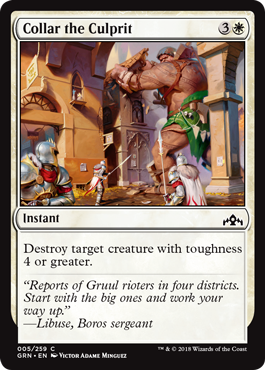
This is another card that caused a lot of debate in the Council of Colors. White has a long history of destroying creatures with power 4 or greater, but never toughness 4 or greater. Was that something white can do? The arguments for it was that white can get rid of big creatures, why was a 4/1 a "big creature" and 3/4 not? The set had a "toughness matters" mini theme and the thought was that this card was just a tweak on a staple white effect.
The argument against it was that we had a color that cared about how tough a creature was and that was red because red's destruction was tied through direct damage. Ah, but that meant red was good at killing lower-toughness creatures not higher-toughness ones (as was black, as it does -N/-N effects). What color was good at killing high-toughness creatures? It wasn't blue or green, as killing creatures with spells isn't their thing.
After a lot of talking, we decided that no one currently did it, but the color closest was white because white did have a "destroy big creatures" thing going on. Note that this is the kind of effect that made sense in this set but is not something I expect us to do all that often.
Connive // Concoct
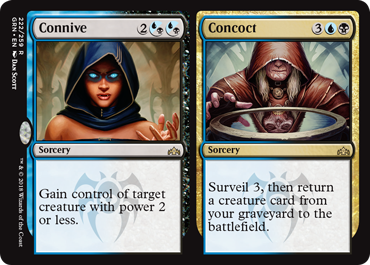
To continue today's theme of Council of Color arguments, let's talk about Connive. The goal of the card was to make a cheap blue-black hybrid instant or sorcery. Blue-black hybrid instants and sorceries are the hardest to do as blue and black have the smallest amount of spell overlap. Clearly blue can gain control of other creatures as it's primary in the ability. Black, though, is tertiary in creature stealing and does it very infrequently.
The problem was the Guilds of Ravnica Set Design team wanted an effect that we hadn't done numerous times in blue-black hybrid, which meant that something was going to have to bend somewhere. As black is tertiary in the effect and the overall card is a limited version of a stealing card (only taking small things), the Council signed off on the card.
Creeping Chill
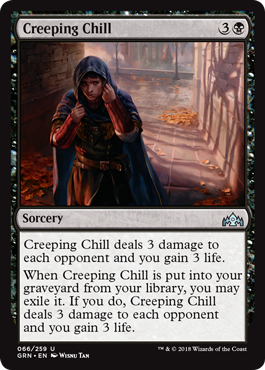
While blue and black do a lot of milling, we actually haven't made a whole lot of cards in those colors that trigger when being milled. (I'll talk about a high-profile one in this set next week.) Creeping Chill was meant to be a card that, when milled, did the effect you would get when you cast it. This is yet another card that caused some discussion in the Council of Colors because there's no color requirement when milled, meaning a mono-blue self-milling deck could, for example, drain people even though that's not something blue can do. I personally would have liked to see some color requirement, but all the versions to do so added a lot of words to the card, which already has a lot of words on it. In the end, it was decided that being a dead card if you draw it is a big downside for a non-black deck.
Leaving the City
And that is all the time I have for today. Obviously, I'm only at c, which means I have a couple columns left to write about cards in City of Guilds. As always, I'm eager to hear your feedback on today's column or Guilds of Ravnica. You can email me or contact me through any of my social media accounts (Twitter, Tumblr, Google+, and Instagram).
Join me next week as I talk about more Guilds of Ravnica cards.
Until then, may you have as much fun exploring the city as we had making it.
#573: Color Talk - Red Speaks
#573: Color Talk - Red Speaks
36:21
I turn over my podcast to the color red, which explains in its own words what it believes. This is part four of a five-part series I'm calling "Color Talk."
#574: Color Talk - Green Speaks
#574: Color Talk - Green Speaks
34:30
I turn over my podcast to the color green, which explains in its own words what it believes. This is part five of a five-part series I'm calling "Color Talk."
- Episode 572 Bad Cards
- Episode 571 Color Talk - Black Speaks
- Episode 570 Color Talk - Blue Speaks

